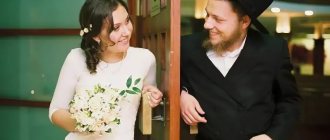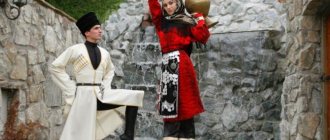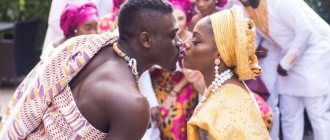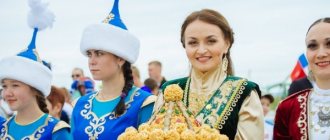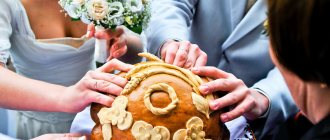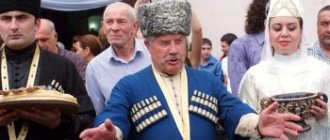An Ossetian wedding is a tribute to the traditions of the ancient state. This is a beautiful and elegant celebration, steeped in ancient legends. The Ossetian wedding is based on the Nart epic, where a modern man and woman play the roles of acting characters. The bride is the daughter of the lord of the waters, and the groom is a brave knight from the Nart tribe. One day, the water princess flies in the form of a dove to the Tree of Life, where she is met by a knight and wounded with his arrow. But the girl does not die, but is cured thanks to the efforts of the young man, after which she becomes his wife. This is the main plot on which Ossetian weddings are based.
Matchmaking
First, the wedding celebration is preceded by matchmaking among Ossetians. A young man who is ripe for marriage sends matchmakers to the girl he likes. There must be three people, each of whom has his own meaning. The eldest is a respected person, most often a neighbor, and the other two guests represent the bride and groom's sides.
In the house, the new arrival of matchmakers is no secret, and what the meeting will be like will influence the outcome of the entire ceremony. However, the elder is obliged to inform after the second toast the reason for the guests' visit. According to etiquette, the girl’s parents should not immediately agree to the matchmaker’s proposal, postponing the decision until the next visit.
Matchmaking traditions in Ossetia consist of several stages, and one of them is “fidyd”. This is the name of a prenuptial agreement when the bride and groom give permission for a family union. This ceremony can take place in the home of the young or young person with the participation of a special person who serves as an intermediary between the parties. He leaves a certain amount of money in the house of the future bride, which is given by the groom's parents for the wedding.
For this day, a special treat is prepared, most often a ram is slaughtered for sacrifice. On this day, the wedding date and all the nuances of the celebration are set. When all the chores have been distributed and agreed upon, the guests move on to the meal. The peculiarities of Ossetian traditions at a banquet are such that ritual dishes must be on the table. These include three pies, as well as the neck and head of a sacrificial ram. Three toasts are made at the table, the first of which is to the Big God, the second to the deities, and the third should glorify the related surnames. After this, three cuts are made on the sacrificial animal, cutting off the ears, and the meat is passed along with the wine to the young.
Traditions of matchmaking in Ossetia
The role of matchmakers among the Ossetian people is usually respected people who are close friends or relatives of the groom’s family. They visit the chosen one's house three times before the family agrees to the girl's marriage. Each time, receiving matchmakers, the girl’s father is polite and hospitable, but refrains from giving a final answer, only making it clear that he is not against this union. After exchanging pleasantries, both parties say goodbye, having previously discussed the date of the next meeting.
One of the main issues discussed at such a council is the size of the bride price. The gap between visits to the house of the guy’s beloved depends on how quickly the groom collects the required amount of money.
During the last meeting, which traditionally takes place in the bride's house, the so-called conspiracy of the relatives of the couple in love takes place. During the conspiracy, the head of the bride's family voices his final decision and both parties agree on the date of the celebration. The agreement is considered to have taken place after representatives of the groom’s family transfer the agreed amount of bride price to the bride’s family.
After these ceremonies, the bride is considered engaged. And from this moment until the wedding, the bride’s life changes. Now she is not allowed to visit entertainment venues, even with her friends, and especially not to meet her future husband’s relatives there.
The next, so to speak, official stage of the pre-wedding tradition is the secret visit of the groom to the bride. Which consists in the fact that the groom, in the company of his close friends, secretly comes to the bride with an engagement ring, which among all nations is a symbol of engagement.
Pre-wedding rituals
The most charming ritual in pre-wedding preparation is called “susagtsid”, which translated means “secret visit”. It is applied a few days after the fidyd has taken place. Her bridesmaids, groom and best man come to the bride's house. As a rule, everything happens secretly and in the evening. The future son-in-law must treat the female half of the house with the sweets that he brings with him. Then the guests are treated to food, and dancing begins on the street and Ossetian folk wedding songs can be heard.
At this feast, you can also hear three toasts of honor, only the third toast this time is dedicated to the happiness of the young. The mother of the bride presents her future son-in-law with a ceremonial glass, and other women present the other men. They must drink the contents to the bottom, and then put money in it and return it to the women.
On this day, the groom gives his bride a wedding ring, after which the real celebration begins with songs and dances. The festivities can continue until late at night, but the groom should not stay overnight in the newlywed's house.
Wedding preparations
When a girl is preparing for a wedding, she has a number of restrictions. It is believed that at this time she should not have fun - she needs to prepare for family life. Therefore, she does not attend entertainment events and organizations, even when accompanied by friends or relatives.
She devotes all her time to helping elders organize the holiday. The second significant restriction is that the girl should not see the groom’s relatives. The last stage is the secret meeting of the bride and groom. The man must, accompanied by friends, come to the bride without being caught.
When he succeeds, he gives his beloved a ring, after which the engagement is considered concluded. In order to meet the girl without causing the anger of her parents and without casting a shadow on her honor, they came up with an interesting way. The groom, along with the witness and the bride's friends, come to her house in the evening. The man must present all the women at home with sweet treats, after which they organize a festive table, on which there must be three pies for the young people.
After this, folk music begins to play in the courtyard, and guests and hosts come out to dance.
There is one peculiarity at the banquet - the mother of the bride must serve a glass of wine to her future son-in-law. And other women of the clan bring dishes to the rest of the guests, not forgetting the groom’s friends with whom he came.
Before drinking the treat, the guys must make a solemn toast. And according to tradition, you need to put money in empty dishes. This demonstrates the man's generosity and wealth. The entire banquet is held so that the man has the opportunity to meet the bride. He must find a moment when they are not being watched and give her an engagement ring.
It is important to do this discreetly, so that later the relatives can be “surprised” that their daughter is suddenly engaged. After the appearance of the ring is discovered, the celebration gains momentum. Almost everyone goes dancing, some start singing or playing musical instruments. The festivities can continue until late at night, but it is important that the groom and his entourage do not stay overnight.
Before marriage, a man and woman should not spend the night under the same roof, even in different rooms.
Wedding
Everyone who participates in the “wedding train” is called “chyndzhassag”, all participants are notified in advance. The head of the wedding train is the elder, who ensures that all the requirements of wedding etiquette are observed. All participants gather at the groom's house, where they get to know each other. Here they will have a light meal and a small meeting about all the nuances of the wedding ceremony. After this, everyone goes to the bride’s house, noisily and cheerfully informing the area about the special event.
Near the house, the participants of the wedding train are met by elders and some guests. They present the young man's side with three pies, beer, araka and other snacks. At this moment, prayers and praises are said to God, as well as wishes that this house will always be pleasing to such esteemed guests. The elder of the wedding train gratefully accepts the gifts and in return blesses the newlywed families, wishing them happiness. His assistants do the same.
This Ossetian wedding ceremony allows you to drink only one glass of wine, offered by the bride’s side. Modern celebrations often violate ancient traditions by offering a “counter glass” each, and if this is not done, they may not be allowed into the house. This is considered a gross violation of the wedding ceremony, therefore, when encountering this, knowledgeable people can simply leave.
After presenting the gifts, they go into the house, where a treat awaits everyone. Toasts and drinking songs are heard again, the mistress of the house tries to please her son-in-law and elders.
Ossetians treat each other with deep mutual respect, which is reinforced by the following ritual. If people in mourning live near the bride's house, the father of the family sends them a letter a few weeks before the wedding. In it, he reports that a wedding will take place on such and such a day, but due to the fact that he deeply respects the grief of his neighbors, he does not know what to do. Neighbors, in turn, should allow other people to enjoy themselves, thus allowing festivities. Such Ossetian wedding ceremonies are very ancient and have not been forgotten to this day.
Another ritual takes place at the table. The eldest of the guests asks for three ribs from a sacrificial ram, after which he passes them along with three glasses to three women. Toasts are said in their honor: the first is dedicated to the girls who prepared the food; the second - to all guests; the third - to the eldest woman in the family.
All this happens while the bride is being dressed. When she is ready, she is not shown until the best man gives a ransom for her. During the bargaining process, various humorous situations occur when young girls want to deceive a guy. The best man and his assistant lead the bride out under the arms. Then the wedding procession goes to the groom's house. Here the bride has to perform some rituals. Before entering the house, she is given a boy to hold so that her first-born son will be a son. The young woman must cross the threshold of her home with her right foot, and then bow three times to everyone present in the room.
How an Ossetian wedding works
If you have been invited to an Ossetian wedding and you want to understand what is happening, or you are an Ossetian who is lost in the variety of wedding customs, or maybe you are just interested in how everything works for this people, our guide will be useful to you. We tell you how Ossetian weddings take place.
Glossary
Minavartta (minæværttæ) - matchmakers Fidyd (fidyd) - conspiracy, custom when the parties come to an agreement Fidaujita (fidaujytæ) - intermediaries in concluding an agreement Shushagsyd (susægtsyd) - secret visit Kuhylkhatsag (to
yukhylkhætsæg) - senior best man
Amdzuardzhyn
(æ mdzuardzhyn) - junior best man
Chinzkhashshag (chyndzkhæssæg) - delegates who went to pick up the bride Shchiakhshi cafetta (siakhsy kafettæ) - sweets from son-in-law Ambalakkag (æmbælægkag) - counter glass Khizhi shan (hyzisæn) - the ritual of removing the veil from the bride Khizhishag (hyzisæg) - a young man removing the veil from the bride Kangamad (kængæmad) - the named mother Hisau (hitsau) - father-in-law, literally the owner Mydykush (mydykus) - a bowl with a mixture of honey and ghee Razgamtta (razgæmttæ) - women's wedding dress Khunzautta (hyundzæuttæ )—a delegation from the bride accompanying the dowry
And now about everything in more detail.
Matchmaking
Although matchmaking is not an element of the wedding ceremony, it cannot be ignored. After the groom's family has approved his choice, matchmakers (minvartta) are sent to the house of the bride's father. In pre-revolutionary times, a lot depended on matchmakers. They were entrusted with the important task of convincing the bride’s relatives that their candidate was the best for the role of the girl’s husband. In modern Ossetia, the matchmaking ritual has changed and become less significant, but it is still an important part of the wedding cycle. Choosing matchmakers is a serious matter. The delegation always includes adult men respected in the groom's family. The groom's parents select matchmakers from among close older relatives (for example, parents' brothers), close family friends or neighbors (neighbors in Ossetia are the same as relatives). Matchmakers must be wise, diplomatic, patient, have a sense of humor and have a good knowledge of Ossetian customs. There are rarely more than five of them. The delegation goes to the house of the bride's father on Saturday evening - it is believed that in the evenings it is easier to avoid the “evil eye”. The bride's family is warned in advance about the visit of guests.
Matchmakers must be wise, diplomatic, patient, have a sense of humor and have a good knowledge of Ossetian customs.
The matchmakers are met by respected people from the bride's side. The parents of the bride and groom should not participate in the negotiations. The bride's family sets the table for the guests' arrival. After a short conversation on abstract topics, the matchmakers are invited to the table where the future union is discussed. The bride's side can reject the matchmakers' offer, but must behave diplomatically and courteously so as not to offend the guests and the groom's family. But matchmakers rarely receive refusals, since matchmaking is usually preceded by a long acquaintance of the young couple. Therefore, matchmakers in modern Ossetia have more of a ritual function. The answer of the receiving party is always agreed upon with the bride and is known even before the guests arrive. According to etiquette, the bride's side does not immediately answer in the affirmative. Matchmakers must visit the bride's father's house at least three times. Although recently the bride's relatives can give consent after the second visit of the matchmakers, in rare cases even after the first. The bride and groom are not present at the negotiations.
Collusion (fidyd)
After the bride's side has agreed to the wedding, the groom's family sends proxies (fidaujit) to the house of the bride's father with money, sealing the marriage agreement. Often they are matchmakers. Previously, the conspiracy served as a platform for discussing organizational issues related to the wedding. All this was accompanied by a traditional Ossetian feast with prayers and good wishes to the two related surnames .
Secret visit (susægtsyd)
A week before the wedding, the groom and his friends secretly come to the bride's house. Important characters appear here for the first time - the senior and junior best men (kukhylkhatsag and amdzuardzhyn). Best men are chosen by the groom's parents or the groom himself from among close friends and relatives. A prerequisite when choosing a senior best man is that he must be married.
The groomsmen become the bride's sworn brothers and must protect and help her throughout her life. The groomsmen come for a secret visit along with the groom and his other friends. Usually there are no more than seven people. On the bride's side, the secret visit is attended by her friends, senior women of the family, mother or paternal grandmother, young neighbors and relatives of the bride. Adult women, as a rule, are in the next room during a secret visit so as not to embarrass young people. After saying the first three toasts and prayers, the groom and his groomsmen go to the older women, where the bride’s mother presents the guests with glasses that were previously filled with low-alcohol Ossetian beer. Modern morals have become more liberal, and strong drinks are also poured into glasses. When the glasses become empty, the guests return them to the women, putting money inside. In addition, the groom presents the future mother-in-law with sweets - they are called that - sweets from the son-in-law (shiakhshi cafetta). And then he gives the bride an engagement ring and a wedding dress. In meaning, a secret visit is close to an engagement.
Wedding
Here we come to the wedding day. Just twenty years ago, Ossetian weddings were held in the house of the groom and in the house of the bride. For guests, awnings were erected near the houses, under which tables were set for the guests. Nowadays, weddings are more often held in restaurants and banquet halls. A wedding in Ossetia is divided into two - the wedding of the bride and the wedding of the groom. The people selected by the senior best man to go pick up the bride gather at the groom's house early in the morning and receive instructions from their elders. The elders offer prayers to the One God and Uastirdzhi, and then bless the young people on their way.
The number of cars in the cortege (chinzkhashshag) that is sent to pick up the bride is not regulated, but etiquette limits the number of persons included in the honorary delegation - most often there are no more than 50. It is recruited from young boys and girls, neighbors, close relatives and friends of the groom. Of course, the groomsmen also travel in the motorcade - they are perhaps the most important people at the wedding. In addition to the youth, several elders also travel in the cortege - they are responsible for the youth and make sure that the groom’s side shows itself in the best light before the bride’s side. The delegation brings the bride pies, bottles of beer and araka, cakes and sweets.
At the threshold of the bride's house, or the banquet hall where the wedding is taking place, the delegates are greeted by elders with full glasses. The eldest member of the delegation thanks the hosts for their hospitality and expresses good wishes to the young people. Then the three elders drink counter glasses (ambalakkag) and invite all guests to come into the room. The guests are seated at the table, and after prayers and feasting, the young people go to dance.
The eldest member of the delegation, after saying the obligatory prayers, presents a glass to the owner of the bride’s house (most often the father) and thanks him on behalf of all the guests. Later, the hosts present glasses of honor to the guests.
All this time, the bride stands in a prominent place - in modern banquet halls a special podium is equipped for her. Later she is taken away and the women help the bride change into her wedding attire (razgamtta). The assistants are in no hurry to give the bride to the groomsmen; the senior best man must buy her back. Bargaining begins, which eventually turns into a playful squabble - neither side gives in, in the end they manage to come to an agreement, and the bride is taken out to the guests. Sometimes young people on the bride’s side jokingly hide the guest girl, and representatives from the delegation ransom her from the kidnappers.
Having bought the bride, the senior best man takes her out to the people, holding her right hand. On the left side is the junior best man. The girl is brought to the elders for a blessing, and they offer prayers to God and the saints so that they will patronize and protect the new family. Modern weddings often replicate the Western custom of the bride throwing her bouquet back without looking. According to legend, the girl who catches the bouquet will be the next to marry. This custom has nothing in common with the traditional Ossetian wedding, although it has become a fun addition to it recently.
Then, to the sounds of an accordion, the girl is put into a white car, and the cortege goes to the groom's wedding. Although the departure of the motorcade can sometimes be delayed. Children who come to the wedding do not want to leave the wedding empty-handed. They stand in front of the car in which they put the bride, like a human shield, and demand money from the senior best man for the opportunity to leave the bride’s territory. After playful haggling, the best man most often throws a wad of money into the air, and the cortege leaves the bride's wedding while the children collect the easy loot.
As soon as the cortege reaches the groom's wedding, the white car is surrounded by people. The bride is brought to the elders, who bless her for life in a new family. The girl is given a baby boy in her arms (so that the first-born is a boy), she crosses the threshold of the new house with her right foot.
The next important stage of the wedding is removing the veil (khizhishan). This ritual is performed by a young man who is well acquainted with Ossetian traditions (khizhishag). Of course, the young man must be a close person in the groom’s house (a younger relative or neighbor, the son of a friend, etc.). The young man brings with him a special attribute - a ritual flag (sary zada khatzil), which he waves three times over the bride’s head and wishes her happiness and abundance, seven sons and a blue-eyed daughter.
A couple of hours after the bride arrives at the wedding, a delegation is sent to the groom, accompanying the bride’s dowry (hunzautta). She is seated at a separate table and received as the most honored guests.
After repeating these ritual words, the young man raises the veil so that people can see the bride's face.
The ritual flag is now kept in the newlyweds’ house as a venerable relic. This ritual introduces the daughter-in-law into a new home. From now on, she is a new member of the family, and the main man in her life is now her husband’s father, he is called hitsau (literally, master).
Along with the ritual flag, a bowl with a mixture of honey and ghee (mydykush) is sent. The bride feeds the mixture to adult women, the mother-in-law feeds the latter, and those around them at this time wish them mutual understanding, an easy and “sweet” life together. After the ceremony, the neighboring boys steal the cup of honey, and the senior best man again has to spend money to buy it back.
The wedding is accompanied by songs and dances. There are a lot of guests at an Ossetian wedding - several hundred, maybe more than a thousand, in very odious cases the number of guests reaches two thousand. In Vladikavkaz, not every celebration hall can afford to accommodate so many people. Guests bring gifts to the wedding, close relatives and best men give the bride jewelry, the rest of the guests, knowing that a wedding is a very troublesome and expensive affair, prefer to give the newlyweds money in order to at least partially cover their expenses.
Having stood in a specially designated corner for the entire wedding, the bride, in the company of two guards from her father’s house, close friends who accompany her throughout the wedding, best men and the named mother (kængæmad), goes into a separate room, where she is finally allowed to sit down. Guests periodically drop in on the bride, and she greets them standing. The guests wish the bride happiness in her new home, harmony with her new household and, as is customary among Ossetians, seven sons and a blue-eyed daughter.
When darkness falls, the groom goes to his father-in-law's house, where his mother-in-law cooks him scrambled eggs. He is accompanied by friends. This custom is called the visit of the son-in-law (siakhsy tsyd). His arrival is eagerly awaited - relatives and neighbors are interested in looking at the bride’s choice. Young people organize dances in his honor, women set the tables. The elder sits usually with one of the neighbors, usually close in age to the guests. The son-in-law gives the women candy and drinks a few glasses with his new relatives, but he controls himself and controls every word and movement in order to make a good impression on his mother-in-law and father-in-law.
The bride and groom don't see each other at their own wedding
After the feast, the groom goes to his mother-in-law, who gives him a glass. The groom's friends are served glasses by other women close to the bride's father's house. The groom thanks his mother-in-law, after emptying the glass, puts a bill into it, and his friends follow his example.
This ends the formal and crowded elements of the wedding cycle.
By the way, the bride and groom do not see each other at their own wedding, although they may be in the same building. The groom meets the guests and accepts their congratulations, and the bride stands in the place assigned to her and also accepts congratulations. She shouldn't speak at the wedding. And she will speak to the groom’s father only when he gives her permission to remove the scarf from her head.
It’s not easy to tell about the beautiful custom of the Ossetian wedding, which has evolved over many centuries, but we hope you get the idea.
The editors thank Aslan Dzgoev for the materials provided.
Mikhail Aboev
5 731
After the wedding
The rituals and traditions of Ossetian weddings do not end even after the wedding ceremony. At the groom's house, the bride's veil is removed, and this must be done by a young man, a relative. The ritual is performed with the help of a wedding flag, which is passed from the bride's house. When the veil is removed, the flag is fixed above the stove, where it should be permanently.
After the ceremony of removing the veil, the bride treats all the women in the house with honey from a special bowl, which is then given to the children. Then the bride is taken back home, where the groom and best man later arrive. Another feast is being held here.
The next morning, the bride treats local children with sweets, and the guests continue to celebrate.
Removing the veil
The ritual of removing the veil from the bride deserves special attention. If previously the veil was removed only on the second day, today it is done on the wedding day. A young guy, who has a special flag in his hands, taken from the bride’s house, pronouncing special words, circles it three times over the bride’s head and with a deft movement of his hand lifts her veil - now everyone can see her face. The flag that was in the guy’s hands after the ceremony is traditionally kept in the newlyweds’ house, serving as a symbol of the girl’s joining the new family.
After the veil has been removed from the girl, the bride must treat her new relatives (the female half) with honey and, without fail, her husband’s mother, and she must treat her. This is precisely what serves as a symbol of a good relationship between mother-in-law and daughter-in-law. After this, the parents of the bride and groom invite each other to visit. After this, newly-made relatives can already visit each other even without an invitation.
Wedding dresses
Ossetian wedding clothes fully correspond to the legendary epic. Grooms rarely wear the Ossetian national costume anymore, but brides do not change traditions. Her outfit symbolizes the body of a dove, in which the divine princess once appeared. It consists of mandatory elements: long sleeves that symbolize the age of marriage, bibs, patterns on the hem of the dress and on the sleeves, and a metal belt. The dress itself should be floor-length and completely covered. The bride's outfit is also complemented by a round cap and veil.
Wedding dresses in Ossetia always have a luxurious and expensive appearance. They are richly and skillfully decorated. The bibs on the bride's dress symbolize the branches of the Tree of Life. A metal belt at the waist protects against evil forces, and the patterns are a strong talisman.
The pattern on an Ossetian wedding dress can be serpentine or floral. They are considered very ancient and highly revered. Ornaments symbolize nature in its various manifestations. They are located along the edges of the dress, where its protective function ends. The cap is also decorated with similar patterns.
At an Ossetian wedding, everything has a fabulous and solemn look. Here you can see many ancient rituals that delight you with their originality.
Varieties
Despite the strict requirement that all mandatory elements be present in an Ossetian wedding dress, the bride still has the right to choose. She can try on outfits where the sleeves are narrow or flared. Can replace the traditional fabric of wedding clothing with a more modern one. For example, a classic white Ossetian bride's dress made of expensive guipure or tulle will, in its style, completely repeat the historical requirements of the outfit of an Ossetian bride.
Arrival for the betrothed
A few years ago, a wedding in Ossetia was celebrated in the groom’s house. Many guests were invited to the event. The festive table was placed in the courtyard. In modern times, young people prefer to celebrate their wedding in a restaurant.
An Ossetian wedding is conventionally divided into two types: the celebration of the bride and groom. In the morning, the future spouse's relatives, neighbors and friends come to his house. The eldest of the best men decides who will go in the cortege to pick up the bride, and also gives several instructions. It is mandatory for the girl's parents, senior and junior groomsmen to follow her. The retinue gives the groom's chosen one pies, cakes, sweets and alcoholic drinks.
They are greeted at the doorstep with glasses of wine. The guests wish the bride and groom well, happiness and long love. Then everyone goes into the house. The bride occupies a prominent and honorable place. But after a few minutes she is taken to an adjacent room, where she can change into a wedding dress.
Details
Outfit Details
The wedding dress of an Ossetian bride includes many details, here are some of them:
– corset – made of several layers of silk;
- a shirt (chintz or silk), red or yellow;
- a metal belt that protects the bride from evil spirits. As a rule, it is decorated with expensive red stones;
- caftan - usually made of expensive fabrics (satin, silk or velvet). Its collar hem is embroidered with gold embroidery;
- apron;
— bib (symbol of the branch of the Tree of Life);
- a hat embroidered with threads (gold and silver) and decorated with beautiful stones, usually ruby in tone;
- a veil, it can be replaced with an airy scarf, worn over the cap and covering the beauty’s face.
The entire suit is made in a swing cut. A caftan is worn on top of the shirt, which fixes the girl’s figure and prevents the fasteners on the chest from unfastening. It is almost invisible from under the dress and is considered more of a decorative element of the wedding composition. Under the caftan the girl is wearing a corset, which is tightened with a cord with multiple knots. According to custom, the corset is untied, and the use of sharp objects is not allowed. It is also prohibited to break the cord.
The sleeves of the swing dress, flared at the bottom, are embroidered with handmade embroidery and rich stones. This makes the dress very heavy, but makes it unusually beautiful and solid. In some dresses, the sleeves are straight, tapering at the wrist. Wide sleeves should be worn on such a sleeve. Ossetian wedding dresses are always luxurious and expensive. The outfit covers all parts of the bride's body, including the neck and arms.
About the headdress
The girl’s headdress (cap) is beautiful, embroidered with gold threads and framed by an airy veil made of several layers. The veil covers the newlywed's head from prying eyes. It should be noted that a veil with a wedding cap made in the shape of a truncated cone is the subject of ransom at a wedding in Ossetia. The headdress is carefully guarded by the bride and groom’s relatives, and guests try to “steal” it. In the old days, it was considered a bad omen if the bride’s headdress fell into the wrong hands. The bride's belt can be made of cloth or silver. It is believed that the richer the belt is decorated, the more prosperous the bride’s family is. The fabric belt is originally embroidered, and the metal belt is a unique masterpiece.
In the old days, the bride's dress was made of red fabric. Modern Ossetian newlyweds wear clothes in light shades (white, pink, cream, blue) with bright elements.
On her feet, the girl puts on soft shoes made of morocco (chuvyaki) with patterns embroidered with gold and silver threads.
The bride is the personification of purity and chastity. Her wedding attire amazes with its luxury and richness.
It is believed that a girl in a wedding dress is very vulnerable and susceptible to the machinations of evil forces, this explains the presence of many amulets and protective patterns.
When the bride in her wedding dress goes to the wedding procession, she is accompanied by the best man. At the same time, the girls sprinkle sugar on the road as a sign that married life will be sweet. According to tradition, this role is assigned to the mother of the bride. On the way to the registry office, the cortege, according to custom, stops at holy places for prayer.
Features of Ossetian traditions at a banquet
An Ossetian wedding, unlike weddings of many other nations, is celebrated in both the groom’s house and the bride’s house at the same time. This is a very large, fun and hospitable event. As a rule, at such weddings there are at least two hundred guests. Acquaintances and neighbors can come to a wedding even if they have not received an invitation, and the hosts are obliged to be hospitable. Traditionally, for the festive table, the owners roast a whole wild boar, brew homemade beer and araka (homemade vodka). In addition, there are many other treats on the table, and most importantly, three pies that symbolize the sky, water and sun.
It all begins in the groom's house, where his friends and relatives are organized into a retinue, which includes: the best man, groomsman and named mother. They all head to the bride’s house, where they are greeted and, after a special prayer, guests are invited to the festive table. And the young bride, accompanied by her friends, goes to put on her wedding attire.
Ossetian wedding traditions and customs
Despite the fact that today many rituals are becoming a thing of the past, Ossetian youth continue to honor their traditions. Therefore, a wedding in Ossetia remains one of the most exciting events in the life of not only young people, but also their families, friends and neighbors, who are considered relatives. Uzbek weddings are still celebrated on the same grand scale. And although, of course, some Ossetian wedding traditions have undergone changes, in general the celebration is held the same as many years ago. It’s not easy to understand all the nuances of the rituals, so the portal www.svadebka.ws has prepared for you a detailed description of each stage of the wedding.
